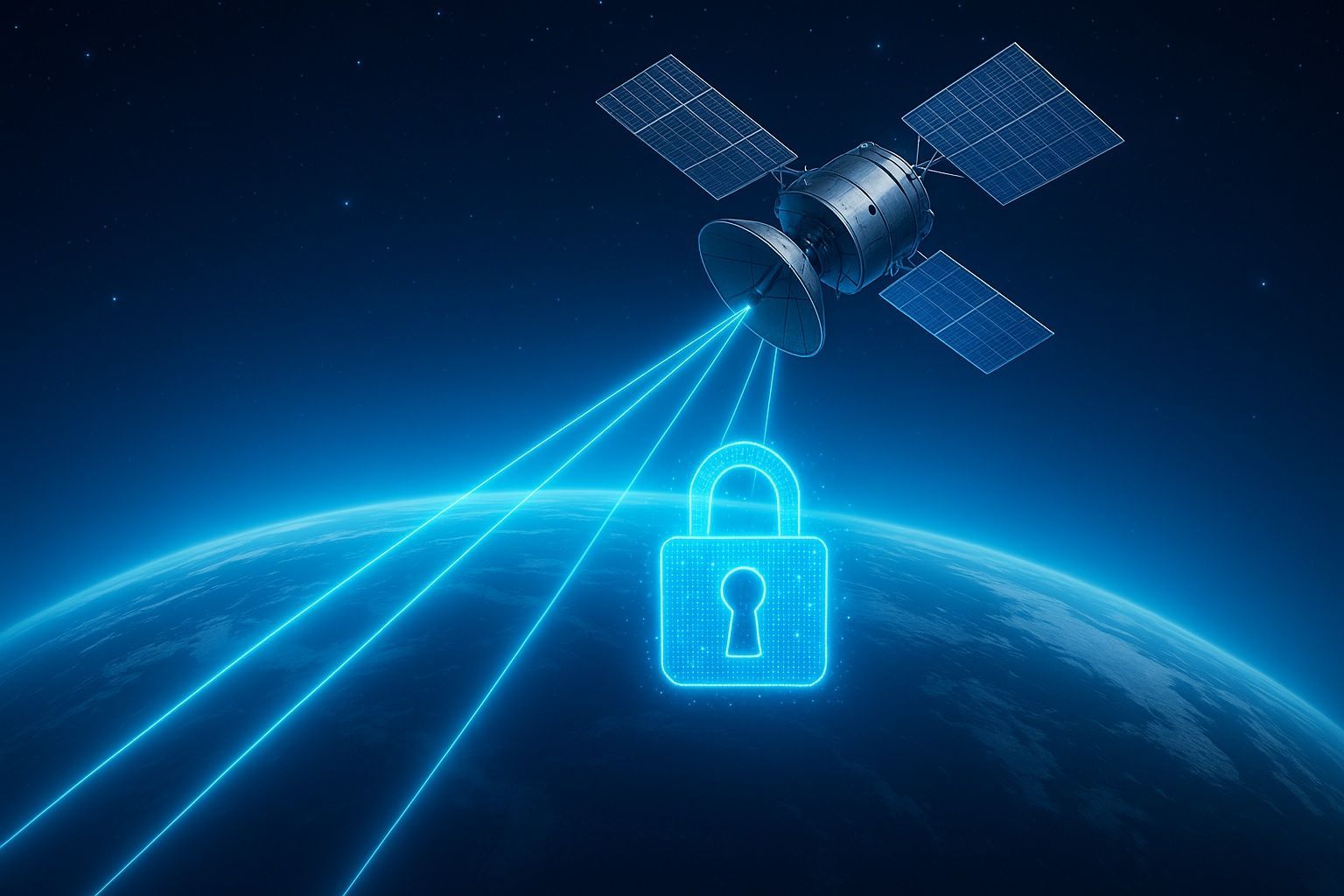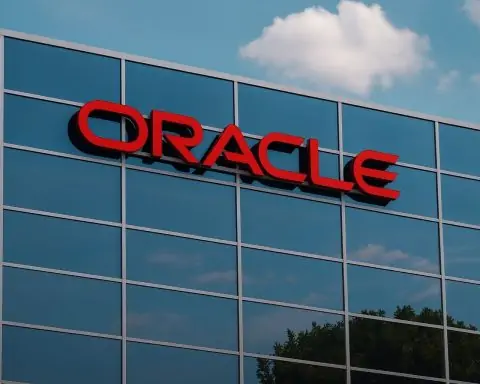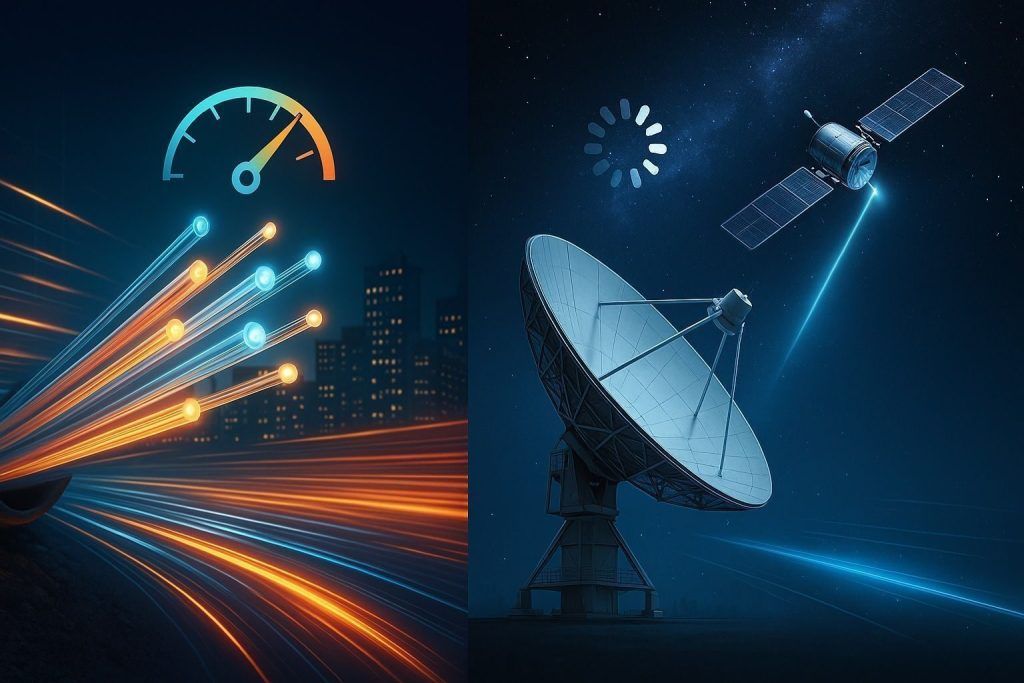- Satellite internet data travels from your dish to a satellite, then to a gateway and onto the internet, with traditional GEO orbits at about 35,786 km and newer systems like SpaceX Starlink using low Earth orbit swarms and inter-satellite laser links.
- Geostationary (GEO) latency is roughly 500–700 ms for a round trip, while Starlink’s low Earth orbit (LEO) latency is about 20–40 ms, impacting secure handshakes such as TLS.
- Signals require line-of-sight, and because satellite beams cover broad areas, adversaries can jam or disrupt links from within the footprint with a powerful transmitter.
- Unencrypted satellite downlinks can be intercepted since signals are broadcast through space, with demonstrations showing that about $300 of off-the-shelf gear can capture and decode traffic.
- Ground infrastructure, including satellite ground stations and Network Operations Centers, is a major attack surface, and experts warn a cyberattack on the ground can disable an entire network (a “common mode failure”).
- On February 24, 2022, the Viasat KA-SAT cyberattack targeted a ground VPN appliance in Italy and pushed a malicious firmware update to tens of thousands of modems, offline about 40,000 modems.
- In 2022 a security researcher implanted a $25 custom circuit board into a Starlink dish to run custom code, and Starlink maintains a bug bounty program paying up to $25,000 for confirmed exploits.
- Security in satellite links relies on AES-256 link encryption and TLS end-to-end, with Starlink claiming “unparalleled end-to-end user data encryption” by default.
- HughesNet and other providers use government-grade cryptography, with HughesNet citing a “Crypto Kernel” and FIPS-140-2-certified modules on newer systems, and some government customers accessing NSA Type-1 encryption options.
- Regulatory and standards bodies, including the FCC, ITU, GDPR, NIST, and Space ISAC, are increasingly focusing on satellite cybersecurity, promoting security-by-design and incident reporting.
Satellite internet is revolutionizing global connectivity—from remote villages to ships at sea—but how safe are these space-age links? This report explores the ins and outs of satellite internet security, from the basics of how it works to the encryption guarding your data, real-world hacks, industry practices, regulations, and cutting-edge defenses on the horizon.
Overview: How Satellite Internet Services Work
In a satellite internet system, your data doesn’t travel through buried cables—it beams up to space and back. The setup has three main components: (1) satellites in orbit (traditionally in geostationary orbit 35,786 km above Earth, though newer systems use low Earth orbit (LEO) satellites only a few hundred km up), (2) ground gateway stations on Earth that connect the satellite network to the internet, and (3) a user terminal (a small dish antenna and transceiver at your home or site) [1] [2]. When you send or request data, your dish communicates with the satellite, which relays the signal to a gateway station tied into the terrestrial internet, often via a central Network Operations Center [3]. This “bent-pipe” relay means all your online traffic hops through space – from your dish to the satellite, down to the gateway, and onward to the web (and vice versa) [4] [5].
Modern systems like SpaceX’s Starlink use swarms of LEO satellites and even laser links between satellites to route data in orbit, reducing reliance on a single ground hub [6]. But whether it’s one high-altitude satellite or thousands of low-flying ones, the fundamental principle is the same: your internet traffic travels through the sky. This unique architecture brings unique benefits – and security challenges.
Key Security Challenges in Satellite Communications
Satellite internet introduces distinct security hurdles compared to terrestrial networks. Some of the key challenges include:
- Latency and Signal Delay: Because of the long distances (e.g. ~36,000 km for GEO satellites), there’s an inherent delay in signal travel. A round trip to a GEO satellite and back can add about 500–700 ms of latency [7]. This isn’t just a performance issue – it can affect security protocols. For example, establishing a secure SSL/TLS connection involves multiple handshakes; over satellite links, these take much longer [8]. High latency can thus degrade or time-out security handshakes and make activities like VPN use or real-time authentication more cumbersome. LEO constellations mitigate this with shorter distances (Starlink’s latency ~20–40 ms), but GEO networks still face this challenge [9].
- Line-of-Sight Vulnerability and Jamming: Satellite signals require an unobstructed line-of-sight. Any obstacle – from tall buildings and mountains to intentional jamming – can disrupt the link [10]. Adversaries can exploit this by jamming the signal (flooding the frequencies with noise) to knock out communications. Because satellite beams cover broad areas, jamming doesn’t require physical proximity to the victim; an attacker with a powerful transmitter in the footprint can interfere. Unlike wired links that an attacker would have to physically cut or tap, wireless space links are open to radio-frequency interference by anyone with the right equipment and line-of-sight.
- Signal Interception and Eavesdropping: Data transmitted via satellite is literally broadcast through space – meaning that, if not encrypted, it can be intercepted by unintended recipients. A satellite’s downlink often uses a wide beam to cover many users, so signals sent to a specific user’s dish also reach others in the area [11]. Attackers with relatively inexpensive gear can listen in. In fact, researchers have demonstrated that with about $300 of off-the-shelf satellite TV equipment, they could capture and decode downlink internet traffic from satellites [12] [13]. In one experiment, a security researcher showed that internet data coming from a satellite to a ship in the Atlantic could also be picked up by an eavesdropper’s dish in Africa because of the broad beam footprint [14]. Intercepting unencrypted satellite signals is surprisingly feasible, which is why strong encryption is absolutely critical (as we’ll discuss below).
- Cyber Attacks on Ground Infrastructure: The satellites themselves might be soaring in space, but the control systems and network operations are grounded on Earth – and thus vulnerable to conventional cyber attacks. If hackers infiltrate a satellite’s ground control station or network management system, they can wreak havoc (from intercepting traffic to issuing malicious commands). These ground stations are often the weakest link in the chain. A sophisticated cyberattack on ground systems could even disable an entire satellite network. Derek Tournear, director of the U.S. Space Development Agency, warned in 2023 that a “common mode failure” cyber attack on ground stations “can take out all your satellites from the ground”, no matter how many satellites you have in orbit [15]. In other words, hacking the ground segment can knock a space network offline just as effectively as blowing up a satellite – making ground station security a major concern for satellite operators.
- Physical and Hardware Risks: Unlike data centers, satellites themselves are hard to physically access for tampering – but they are exposed to other physical risks. Adversaries could attempt to physically damage or destroy satellites (anti-satellite weapons, etc.), though that crosses into kinetic warfare more than cyber security. On the ground, however, the satellite dishes and user terminals could be stolen or tampered with. There have even been instances of researchers hardware-hacking user terminals: e.g. in 2022, a security researcher implanted a $25 custom circuit board into a Starlink dish to successfully execute custom code on it [16]. Such hardware hacks could potentially expose the network if not mitigated (SpaceX runs a bug bounty program to catch these vulnerabilities [17]).
In summary, the open-air nature of satellite links and the complex ground-space system expand the attack surface: high latency impacts security protocols, over-the-air signals invite interception and jamming, and ground systems offer fertile ground for cyber intrusion. Next, we’ll see how encryption is used to counter many of these threats.
Encryption and Security Protocols in Satellite Internet
To protect against eavesdropping and tampering, satellite internet services employ robust encryption—often similar to the standards used in terrestrial internet, with some custom twists:
- Link Encryption with AES: The backbone of confidentiality for many satellite links is the Advanced Encryption Standard (AES). Modern satellite ISPs typically encrypt data as it travels between user terminals, satellites, and gateways using AES with strong 256-bit keys [18]. For example, SpaceX’s Starlink uses AES-256 to secure the data exchanged over its network, ensuring that the content of users’ internet traffic is not readable to prying ears in between [19]. AES is a symmetric cipher considered highly secure and is widely used in Wi-Fi, VPNs, and now satellite comms. Even older satellite providers (HughesNet, Viasat) have incorporated AES-based encryption into their modems and network equipment, some of which are certified to government standards (e.g. FIPS 140-2 certification for Hughes’ HX routers) to assure high-grade cryptographic security [20] [21].
- Transport Layer Security (TLS): On top of link-level ciphers, satellite internet users also benefit from the same TLS encryption that secures the web and other applications. TLS (often still referred to as SSL) is the end-to-end encryption protocol used when you see “https://” in your browser. Starlink, for instance, explicitly employs TLS to protect data from the user’s device through the satellite network [22]. This means that even as the data is beamed through space, it’s encapsulated in the same secure protocol that internet banking or email services use. In effect, there are layers of encryption: the satellite link itself is encrypted (think of it like an encrypted tunnel), and within that, TLS provides another layer of encryption for individual connections like browsing or messaging. This dual approach (sometimes called “defense in depth”) ensures that even if one layer were somehow breached, the data would likely still be safe behind the other. In Starlink’s case, commentators have noted it’s like “dual encryption”: Starlink’s system encrypts data at the link level (AES-256) and users still have their normal application-level encryption like TLS on top [23] [24].
- End-to-End Encryption: Beyond the provider’s own measures, any end-to-end encryption used by applications (for example, VPN connections, or apps like Signal/WhatsApp for messaging) will also protect satellite internet traffic. From the user’s perspective, using a VPN over satellite adds an extra encrypted tunnel from their device to a distant server, on top of the satellite link’s encryption. This can greatly enhance security (and is recommended, especially on older networks where link encryption might be weaker), though it may further increase latency. Notably, Starlink claims “unparalleled end-to-end user data encryption” by default on its service [25]. While details are not fully public, this likely refers to the combination of link encryption and the fact that only the intended endpoints can decrypt the content. Providers also isolate user traffic to prevent customers from eavesdropping on each other (even if signals overlap, each modem only accepts traffic addressed to it, often enforced by encryption keys unique to each terminal).
- Authentication and Control Channel Security: Encrypting user data is one thing; securing the control signals and satellite commands is another crucial aspect. Satellite systems use authentication and encryption for command and telemetry links to prevent spoofing. For example, military satellite systems employ NSA Type-1 encryption devices to secure control signals. Commercial constellations similarly protect their control channels—Starlink, for instance, reportedly uses encrypted and authenticated commands so that outsiders cannot steer or disrupt satellites. Without strong control-channel security, an attacker could potentially send malicious commands (as was speculated in some past incidents). Thus, modern satellites and ground stations use robust cryptographic keys to authenticate any commands.
In short, encryption is the linchpin of satellite internet security. Data is typically encrypted at every hop: from your computer to your dish (often via Wi-Fi with WPA2 encryption), from the dish to the satellite and back to Earth (AES/TLS), and again through any public internet links. One HughesNet document notes that “satellite network security tends to be very robust, with all data encrypted on its journey from your computer to orbiting satellites, from satellites through NOCs to the internet, then back again” [26]. This multi-layered encryption is necessary because, as discussed, the signals are inherently exposed during transmission. Encryption scrambles the content, so even if an attacker intercepts the radio signal, all they get is indecipherable noise without the decryption keys.
Historical and Modern Examples of Satellite Hacks
Despite strong security measures, satellite internet systems have experienced breaches and attacks—some by researchers as warnings, others by malicious actors. Below are a few notable incidents, both historical and recent, illustrating the range of threats:
- 1999 – The Sky Satellite Ransom: In a early high-profile case, hackers reportedly took control of a British military satellite (part of the UK’s Skynet constellation) and attempted to extort the UK Ministry of Defence. Operators noticed one of the satellite’s orbits had been altered without authorization; shortly after, they received an anonymous ransom demand in exchange for regaining control of the satellite’s guidance system [27]. An intelligence source called it a “nightmare scenario.” While details remain shrouded (and some question if it truly occurred as reported), this incident showed that even in the late ’90s, attackers were eyeing satellites as targets for hijacking and blackmail.
- 2007–2008 – US Environmental Satellites Breached: During 2007 and 2008, hackers (suspected to be state-sponsored, possibly Chinese) interfered with two U.S. government satellites, NASA’s Terra EOS and the Landsat-7 imaging satellite [28] [29]. According to a U.S. congressional report, the attackers achieved all steps needed to issue commands, though in these instances they apparently did not try to permanently alter satellite function [30]. The breaches were done through the satellites’ ground station connections, highlighting (again) that the ground segment was the entry point. This revelation sent shockwaves through the aerospace community and underscored that satellite systems were not immune to the kinds of cyber intrusions plaguing other IT networks. In response, commercial satellite operators started touting security as a differentiator, realizing that customers would demand better safeguards [31].
- 2015 – Eavesdropping on DVB-S Broadband: Academic researchers have repeatedly shown that many commercial satellite internet links, especially older DVB-S/DVB-S2 based broadband to ships or remote regions, lacked proper encryption. In one 2015 demonstration, a team used a ~$100 satellite TV tuner and dish to intercept internet traffic from a satellite beam covering the Middle East and North Africa, picking up hundreds of unencrypted data streams including sensitive information like corporate VPN sessions and personal emails. Similarly, at Black Hat 2020, Oxford researcher James Pavur presented findings after intercepting wide-beam satellite internet signals: he was able to collect real-world internet traffic of unaware users (e.g. downloading unencrypted HTTP data) using a basic flat-panel TV satellite dish and a satellite tuner card [32] [33]. Pavur’s talk showed how satellite downlinks, if not encrypted, can be a treasure trove for spies or hackers – emphasizing why modern providers must encrypt all data. (It also demonstrated the geopolitical quirk of satellites: signals meant for a maritime customer or African ISP often spill over into other regions, meaning someone on a different continent could spy on data if it’s not secured [34].)
- 2022 – Viasat KA-SAT Cyberattack: One of the most consequential satellite hacks occurred on February 24, 2022, the day Russia invaded Ukraine. A sophisticated cyberattack targeted Viasat’s KA-SAT consumer broadband network, which served Ukraine and other parts of Europe. Attackers penetrated a VPN appliance at a Viasat ground station in Italy and used that access to push a malicious firmware update (wiper malware) to tens of thousands of satellite modems [35] [36]. Within minutes, ~40,000 modems across Ukraine and Europe were knocked offline – essentially “bricked” by the malware wiping their flash memory [37]. This caused widespread outages, even disrupting the remote monitoring of thousands of wind turbines in Germany that relied on Viasat links [38]. Western governments formally attributed the attack to Russia [39], calling it a stark example of cyber warfare extending into space infrastructure. The Viasat hack is arguably the largest publicly known cyberattack on a satellite internet network. It highlighted the importance of securing not just the satellite signals but the ground network and management interfaces. In response, Viasat worked to replace customer modems and harden its systems, and governments sharpened focus on satellite cybersecurity. Lessons learned included segmenting networks to limit spread of malware and enhancing monitoring of network anomalies [40] [41].
- 2022 – Starlink Under Attack (and Adaptation): SpaceX’s Starlink has also been tested by both researchers and adversaries. In 2022, a security researcher used a homemade modchip to hack a Starlink user terminal, successfully breaking into the dish’s software [42]. He disclosed the vulnerability through Starlink’s bug bounty program, prompting firmware fixes. Around the same time, Starlink was actively being targeted in conflict zones: Russia attempted to jam Starlink signals in Ukraine using electronic warfare units. In one public instance, SpaceX’s CEO Elon Musk noted that Starlink faced “jamming attacks” but resisted them by rapidly updating the system’s software and strengthening signal encryption/frequency hopping, effectively cyber “patching” the constellation in real-time [43] [44]. Additionally, Starlink claims that none of its satellites adhere to the outdated (and insecure) legacy protocols that some older satcom systems use, and it employs a modern “zero-trust” architecture in its network design [45]. The cat-and-mouse between Starlink and attackers (both researchers and hostile state actors) shows how satellite ISPs must be agile in defending against emerging threats. It’s a new era where a dish on your roof might receive firmware updates to fend off cyber attacks just as your laptop does.
These incidents demonstrate both the ingenuity of attackers and the evolving defenses of satellite operators. From literal satellite hijack attempts and widespread modem sabotage to ethical hacks that strengthen security, the satellite internet arena has become a frontline for cybersecurity. Each breach or demo provides lessons that feed back into better security practices.
Security Practices of Major Satellite ISPs
How do today’s leading satellite internet providers protect their networks and customers? Let’s look at a few major players and their security approaches:
- Starlink (SpaceX): Architecture: Starlink’s LEO constellation inherently offers resilience (thousands of satellites mean no single point of failure in space). Encryption: Starlink applies end-to-end encryption by default on user traffic [46]. Data between user terminals, satellites, and gateways is encrypted (reportedly using AES-256), and Starlink leverages the standard internet TLS protocol on top for all user communications [47]. Dynamic Response: Starlink has shown an active security posture – when faced with jamming or threats, SpaceX updates the system rapidly. In Ukraine, for example, Starlink reportedly deployed a software update within days to counteract Russian jamming attempts, improving signal encryption and spectral agility to maintain service [48]. Zero-Trust & Hardening: The network is built on a “zero-trust” model, meaning every access is continuously verified and minimal privileges are given [49]. This limits the damage if one terminal or gateway is compromised. SpaceX has also launched Starshield, a high-security version of Starlink for government use, which adds “additional high-assurance cryptographic capability” on top of the baseline Starlink encryption [50] (likely including on-board encryption modules and even quantum-resistant algorithms for military clients [51] [52]). Bug Bounties: Unusually for a telecom ISP, SpaceX runs a bug bounty program for Starlink, paying security researchers who find vulnerabilities (up to $25,000 for a confirmed exploit) [53]. This crowdsourced testing helps them patch issues (such as the modchip hack) before bad actors exploit them. Overall, Starlink’s practices – strong encryption, rapid patching, zero-trust, and inviting outside scrutiny – indicate a modern, proactive stance on security.
- Viasat: Viasat operates both consumer broadband satellites and handles many government and military communications contracts, so it brings a security-focused pedigree. Encryption: Viasat provides Type 1 encryption solutions (NSA-certified) to government customers and claims end-to-end encryption capabilities for its networks [54]. Its satellites (like ViaSat-3) and ground systems support high-grade cryptography. For consumer services, Viasat’s network (including the KA-SAT system it acquired in Europe) uses encryption on subscriber links, though the 2022 incident showed that internal management networks need equal protection. Post-2022 Improvements: After the KA-SAT hack, Viasat stated it was “leveraging lessons learned to further enhance security features” across its products [55]. This includes better network segmentation (to prevent an intrusion in one segment from affecting all modems), stronger authentication for remote access, and closer monitoring for anomalous patterns (like the sudden surge of malicious modem update traffic that occurred). Viasat also collaborates with government cybersecurity centers (like the NSA’s Cybersecurity Collaboration Center) to share threat intelligence [56]. Physical/Cyber Convergence: As a contractor for military satcom, Viasat integrates jamming resistance and cyber defenses (one example: their resilience against GPS spoofing in aviation connectivity). The company’s dual role in consumer internet and defense means it often applies military-grade security tech to commercial services. However, the KA-SAT attack was a wake-up call that even a robust company can be caught off-guard; Viasat has since reinforced that incident response readiness is as important as prevention [57].
- HughesNet (Hughes Network Systems): HughesNet is a long-running GEO satellite internet provider (serving many rural users in the Americas). Encryption: HughesNet emphasizes that all user data on its network is encrypted from the customer’s dish all the way through the satellite and ground network [58]. Their user modems and gateways use proprietary protocols that integrate encryption (and they have undergone certifications for government use, such as FIPS-certified crypto modules [59]). Hughes also developed an advanced “Crypto Kernel” for its newer Jupiter system satellites – essentially a hardened encryption engine in both space and ground components to secure communications. Security Features: Because GEO satellites have higher latency, Hughes has optimized its protocols to maintain security without excessive overhead. For example, they use techniques like TCP acceleration and pre-fetching (while still upholding encryption) to avoid timeouts in secure handshakes. HughesNet provides standard ISP security features to users (like optional usage of VPNs, etc.) and educates customers on safe practices [60]. Notably, Hughes also partners with defense – their technology underpins some military satcom services – which means their commercial offerings benefit from that security rigor. Managed Security Services: In recent years, Hughes started offering managed cybersecurity services to enterprise customers of its satellite links [61]. This includes network monitoring, intrusion detection, and cloud-based firewalls specifically tailored for satellite-connected sites, indicating that simply providing an encrypted pipe isn’t enough – you need active defenses watching the traffic patterns for attacks.
- Others (OneWeb, etc.): Other satellite ISPs follow similar practices. OneWeb, for instance, uses encryption in its Ku-band LEO system and has partnered with cybersecurity firms to design its network security from the ground up, given many OneWeb customers are governments and businesses that demand it. ViaSat-Inmarsat (the two are merging) will likely combine Inmarsat’s experience in secure satcom (for aviation and maritime) with Viasat’s. Amazon’s Project Kuiper (upcoming) has stated it will prioritize security and reliability, likely learning from predecessors. Across the board, major satellite internet providers are embracing a security-by-design philosophy – encryption of user data as table stakes, zero-trust network assumptions, regular software updates (satellites now can get firmware patches), and comprehensive monitoring.
It’s worth noting that unlike early internet days, today’s satellite ISPs know that security is non-negotiable. They market it: HughesNet tells consumers satellite internet is “top-notch” in security [62], and Starlink’s website highlights encryption and privacy. This is partly due to customer demand (nobody wants a “wild west” connection) and partly due to regulatory expectations (e.g., protecting customer data as required by laws like GDPR, discussed next).
Regulatory and Legal Frameworks for Satellite Internet Security
Satellite internet exists in a web of international and national regulations that shape security and privacy requirements. Some key frameworks include:
- Federal Communications Commission (FCC) – United States: The FCC regulates satellite communications in the U.S., mainly focusing on spectrum, licensing, and reliability. While historically the FCC hasn’t prescribed specific encryption standards for commercial satellites, it does enforce rules against signal interference and eavesdropping. Intentional interference with satellite signals is illegal (violating the Communications Act and FCC regulations). Moreover, the FCC has been increasingly interested in cybersecurity of communications networks: it has proposed requiring ISPs (possibly including satellite providers) to implement baseline cybersecurity plans and report incidents [63]. Following high-profile attacks, U.S. authorities also treat satellite networks as part of critical infrastructure. The 2022 Viasat hack, for example, prompted discussions at the FCC and Congress about hardening satellite systems. Additionally, satellite ISPs in the U.S. must comply with lawful intercept laws (CALEA), which affects how they design encryption – they may need a mechanism to provide law enforcement access to data under court order, meaning encryption has to be implemented in a way that’s robust against hackers but still allow legal intercept (often done by decrypting at secure gateways if required). The FCC is also active in space-specific security matters, like orbital debris (for physical safety) and has started inquiries into satellite and space system cybersecurity as part of its space bureau’s mandate.
- International Telecommunication Union (ITU): The ITU (a UN agency) coordinates global satellite spectrum and orbital slots. While it doesn’t directly enforce cybersecurity, it sets Radio Regulations that all space communicators must follow – chiefly, avoiding harmful interference. By international treaty, willfully interfering with another country’s satellites is prohibited, though enforcement is tricky. The ITU also publishes recommendations on network security best practices. For instance, it has issued guidance on securing network management for digital satellite systems and on combating cyber threats in telecom networks [64]. The ITU’s development arm works with nations on cybersecurity capacity, which increasingly includes satellites. Recently, there’s been discussion in ITU forums about developing specific standards for satellite cybersecurity and incident reporting, but these are nascent. In essence, the ITU establishes a cooperative baseline (don’t jam each other’s satellites; work together on standards), leaving actual security implementation to operators and national laws.
- Data Protection Laws (e.g. GDPR in the EU): Satellite ISPs that operate in or serve customers in regions like Europe must obey data privacy laws just like any ISP. The EU’s General Data Protection Regulation (GDPR), for example, imposes strict rules on protecting personal data [65]. This means satellite providers need to ensure customer data is transmitted and stored securely (encryption is a recommended measure under GDPR for data in transit). If a satellite network suffered a breach exposing personal data, the operator could face fines just as a terrestrial telecom would. GDPR also raises interesting jurisdiction questions: a satellite beam might cover multiple countries, and data may hop through ground stations in various regions. Providers have to architect compliance (for instance, ensuring a European user’s traffic is handled in accordance with EU privacy rights even if the satellite’s gateway is elsewhere). Other laws, such as sector-specific regulations (like HIPAA for health data in the U.S.) also compel satellite internet services to maintain confidentiality and security [66] [67]. In practice, major satellite ISPs have privacy policies and security measures mirroring those of fiber/cable ISPs to meet these obligations.
- Industry Standards and Govt. Guidelines: Various non-binding frameworks influence satellite security. The U.S. National Institute of Standards and Technology (NIST) has published guidance on satellite cybersecurity (e.g., NISTIR 8270) and includes satellites in its cybersecurity framework profiles. Organizations like the Space ISAC (Information Sharing and Analysis Center) facilitate sharing threat intel among satellite operators. In Europe, the NIS Directive (Network and Information Security directive) classifies satellite communication as an essential service, requiring operators to take appropriate security measures and report incidents. Additionally, militaries and agencies (NASA, ESA) set high bars for any commercial providers they use, effectively raising the standard. For example, after the Viasat incident, aerospace industry groups began pushing “zero-trust architecture” and supply chain security for satellites, and Lockheed Martin announced efforts to adopt such principles for its satellite offerings [68].
- Legal Deterrents: Hacking or interfering with satellites is a crime in virtually all jurisdictions – falling under laws against unauthorized access, sabotage, and communications interference. The challenge, of course, is attribution and enforcement, especially if attacks are state-sponsored. Nonetheless, the legal framework (from national criminal statutes to international law) nominally deters many would-be attackers. There’s even discussion of treating severe cyberattacks on satellites as violations of the Outer Space Treaty or as acts of war if they cause significant disruption. In 2022, the European Union, U.S., and allies formally condemned the Viasat hack as an unlawful cyberattack by Russia [69], a notable diplomatic invocation of international law in response to a satellite cyber incident.
In summary, regulators and laws are gradually catching up to the new security needs of satellite internet. They emphasize protecting users’ data and the reliability of these critical networks. While technical standards are largely left to industry, the trend is toward more oversight. Satellite ISPs now find themselves not only needing to secure their networks for business reasons, but also to comply with a patchwork of rules ensuring they keep customers safe and critical services online.
Securing Ground Stations and User Terminals
As highlighted earlier, the ground segment is often “where the action is” for satellite cybersecurity. Ground facilities and user hardware are the interface between cyberspace and outer space, and they demand special security considerations:
- Ground Station Protection: A satellite ground station (gateway or control center) is essentially a data center with giant antennas—so it faces all the usual cyber threats (malware, intrusions, DDoS attacks) plus some physical ones (targeting of the antenna or facility). Security at these stations is multi-layered. Physically, they are usually in secure locations with restricted access, surveillance, and sometimes military protection (since they might be strategic assets). On the network side, operators implement strict access controls, firewalls, and network segmentation. The Viasat hack taught everyone that even a small misconfigured VPN appliance can be an entry point to bring down a whole network [70] [71], so now there’s heavy emphasis on code auditing, employee training, and zero-trust principles for ground station IT. Ground stations also often run specialized software to manage satellites; these must be kept updated to patch vulnerabilities (not always easy if the system is bespoke). Monitoring and anomaly detection is crucial: operators watch for any unusual commands or data traffic at ground stations that could indicate an intruder’s presence.
- Network Operations Centers (NOC): The NOC is the brain of a satellite ISP’s network, often controlling network routing, user authentication, and system health. Securing the NOC means securing the nerve center. Best practices include strict role-based access (only authorized engineers can issue certain commands), multi-factor authentication for remote access, and rigorous logging of every action. Some operators even simulate insider attacks to test if a rogue admin could cause damage, and then build safeguards (like requiring dual approval for critical commands to satellites). Given that NOCs handle traffic from potentially millions of users, they are also a point to implement intrusion detection systems (IDS) that scan for malware or anomalies in user traffic (without violating privacy, usually by looking at metadata/patterns). Modern NOCs integrate AI tools to sift through masses of telemetry and alert human operators to potential security incidents in real-time.
- User Terminal Security: The dish and modem at a user’s home might seem mundane, but they are part of the secure ecosystem too. Providers now often ship customer premises equipment with secure default configurations – for example, the Wi-Fi router in a Starlink or HughesNet setup comes with WPA2 encryption and a preset unique password, to prevent local Wi-Fi snooping [72]. The firmware on satellite modems is usually cryptographically signed by the provider, so that it cannot be altered or downgraded by an attacker; and updates are pushed securely (the Viasat hack subverted this, teaching providers to harden update mechanisms with verification and perhaps out-of-band validation) [73]. Some user terminals (like Starlink’s) also encrypt the traffic between the dish and the Wi-Fi router unit. Additionally, antennas can be targets of tampering – there have been cases of pirates physically modifying satellite TV LNBs to get free access, etc., so for two-way internet dishes, providers sometimes include tamper-evident seals and will deactivate accounts if hardware seems compromised.
- Preventing Unauthorized Use: Satellite networks often implement authentication so that only authorized modems can use the service. This might involve a smartcard or embedded cryptographic chip in the modem that authenticates to the network (somewhat like how a cable modem authenticates). This prevents someone with off-the-shelf gear from just tuning into the network and transmitting. It also means if a modem is stolen, the company can disable it remotely. The flip side is that this authentication must be kept secure – if hackers ever extracted the credentials from a device, they could impersonate it on the network. Therefore, modern terminals store keys in secure hardware modules that resist extraction.
- Redundancy and Backup: Security isn’t only about preventing hacks – it’s also about ensuring availability. Ground stations often have backups and redundancy (multiple stations can take over if one is down). Some satellite operators have agreements to use each other’s gateways in emergencies. They also maintain backup communication paths (for instance, if the primary control station is compromised or knocked out, a secondary station can send commands to the satellites). These contingencies are part of security planning to handle worst-case scenarios like a ransomware attack on a ground facility or even a local power outage.
The overarching theme is that ground infrastructure needs as much protection as the satellites themselves. As one expert quipped, “you can’t launch a hundred secure satellites and then connect them to a hacked router on Earth.” The industry has taken this to heart, increasing investment in ground segment cybersecurity. Agencies like the U.S. Space Force explicitly warn that without securing ground stations, proliferated satellites won’t help – all could be taken down via the ground [74]. Consequently, satellite ISPs treat their gateways like critical fortresses in cyberspace.
The Future of Satellite Internet Security
Looking ahead, as satellite internet continues to expand, so do efforts to bolster its security. Here are some emerging trends and technologies shaping the future of satellite cybersecurity:
- Post-Quantum and Quantum Encryption: With the threat of quantum computers on the horizon, satellite companies are starting to explore quantum-resistant encryption algorithms and even quantum key distribution. Military and high-security satellites (e.g., Starlink’s military Starshield variant) are reportedly “using quantum-resistant encryption to secure data against emerging threats” [75] [76]. This means adopting new cryptographic schemes (like lattice-based or hash-based algorithms) that even a quantum computer can’t easily break. On another front, satellites might themselves enable quantum encryption: China demonstrated quantum key distribution (QKD) from a satellite in 2017 (the Micius satellite), using quantum physics to securely share encryption keys. In the coming years, we may see quantum-encrypted satellite links where secret keys are exchanged via QKD satellites—providing theoretically unbreakable encryption, as any eavesdropping on a quantum key exchange is detectable. The European Space Agency is already supporting projects to deploy QKD satellites for European secure communications [77]. While still in experimental stages (and requiring specialized hardware), quantum encryption technology could become a cornerstone of satellite internet security for governments and even eventually commercial users who need ultra-secure links.
- AI-Enhanced Threat Detection: The use of artificial intelligence is growing in satellite operations, including security. AI and machine learning systems can sift through vast telemetry and communication data to detect anomalies—whether it’s an unusual pattern of signals that might indicate jamming, or suspicious access attempts in the network. AI-driven security can help predict and counteract attacks in real-time [78] [79]. For instance, an AI might learn the normal traffic patterns of a satellite network and flag if there’s a sudden flood of traffic that looks like a DDoS attack on the ground station, or if a normally stable satellite suddenly starts changing its telemetry in a way that suggests malicious commands. According to a recent Space Review analysis, key initiatives in the industry include deploying “AI-powered anomaly detection systems to identify suspicious activities in satellite networks” before they cause damage [80]. In practice, this could mean faster incident response – possibly even autonomous cyber defense actions taken by the satellite or network (like automatically isolating a compromised segment). AI is also being used to optimize encryption and network configurations on the fly to dodge interference or to validate software updates for signs of tampering.
- Improved Satellite Autonomy and Resilience: Future satellites are likely to be smarter and more independent in defending themselves. This includes on-board intrusion detection (monitoring for unauthorized commands or software changes on the satellite), the ability to auto-isolate or reboot if a cyber anomaly is detected, and using alternative communication paths if primary ones are jammed or compromised. Inter-satellite links (like Starlink’s laser links) can add security by routing data in space where it’s harder to intercept, and by providing multiple pathways (if one satellite is under attack, traffic can be handed to another). There’s also research into satellites that can frequency-hop or beam-hop rapidly such that it’s very hard for an adversary to lock onto them for jamming – essentially blending spread-spectrum techniques with agile phased-array antennas. All these make the next generation of constellations more robust against both cyber and electronic threats. In conflicts, we’ve already seen satellites used in “rapid reconstitution” – e.g., a cyber-attack knocks out some capacity, and companies like SpaceX launch new satellites or repoint others to fill the gap in weeks, an unthinkable speed decades ago [81]. This agility is a form of security: the ability to quickly replace or recover from an attack.
- Global Cybersecurity Collaboration: Recognizing that satellites cross borders, there’s a push for more international cooperation on satellite cybersecurity. Alliances and working groups are forming to share best practices. For example, the Five Eyes intelligence alliance (US, UK, Canada, Australia, NZ) has reportedly been sharing information on satellite cyber threats and coordinating protective measures [82]. The World Economic Forum and other international bodies have initiated discussions on space infrastructure cybersecurity norms [83]. We may see voluntary security certification programs for satellite operators (similar to how terrestrial telecom gear can be certified secure by labs). Regulators might also mandate cybersecurity audits for satellite networks that serve critical functions. All of this aims to raise the security baseline globally, so that a vulnerability in one operator (which could affect others, given interconnected services and shared spectrum) is addressed collectively.
- User Empowerment and Transparency: Future satellite services might offer users more visibility and control over security. For instance, a satellite ISP could provide a dashboard showing if your terminal is experiencing interference or suspicious activity. They might allow power-users to opt for even higher security modes (like only connecting through a VPN hub provided by the ISP). We might also see end-to-end encrypted satellite messaging or VPN services bundled, leveraging satellites for private networks. Transparency reports could become common, where satellite ISPs disclose government data requests or cyber incidents to build trust. Essentially, as satellite internet becomes more mainstream, users will demand the same or greater level of security assurance as they expect from fiber or 5G – driving providers to be more open about their protective measures.
- Integration with Terrestrial Networks and 5G Security: Satellite internet isn’t developing in a vacuum; it’s increasingly converging with terrestrial networks (e.g., hybrid 5G systems that switch between satellite and ground towers). This means satellite security will merge with telecom security. The 5G standards already include provisions for integrating satellite links, and they carry forward strong encryption and authentication from 4G/5G. So a future smartphone might seamlessly use a satellite in areas with no cell coverage, and the user won’t notice – but the security (SIM authentication, 5G encryption) will seamlessly apply over the satellite hop. This convergence will likely import the robust security framework of cellular networks into satellite communications, which is a good thing. It also raises new considerations, like ensuring the handoff between terrestrial and satellite doesn’t introduce vulnerabilities and that billing/identity systems remain secure.
In essence, the future of satellite internet security is about staying ahead of the curve – adopting next-generation encryption before attackers catch up, using AI and automation to guard an ever-growing attack surface, and building an ecosystem where space-based internet is as trusted as any wired connection. Given the rapid growth of constellations and their importance (for civilian and military use), we can expect significant investments and innovations in securing “the sky grid.” The goal is that users can take advantage of global satellite broadband without worrying whether some hacker on the other side of the world—or the other side of the galaxy, for that matter—can snoop on or disrupt their connection.
Conclusion
Satellite internet has evolved from a niche last-resort option into a cornerstone of global connectivity. Along with that evolution has come a heightened focus on security. We’ve seen that the challenges are unlike those in terrestrial networks: when your data is literally airborne, it becomes a target for anyone under the footprint; when your network spans Earth and space, a breach can have outsized impact. Yet, the industry is meeting these challenges with equally unique solutions – from layered encryption blanketing every transmission, to hardened ground stations, rapid response to threats, and even quantum keys beaming down from satellites.
No system can be 100% impervious, but today’s satellite ISPs are increasingly robust. They are learning from past incidents (sometimes the hard way, as with Viasat) and from proactive research (ethical hacks like on Starlink) to continually improve defenses. Meanwhile, regulators and international bodies are starting to treat satellite networks as critical infrastructure that must be protected and trusted.
For the average user, the takeaway is encouraging: satellite internet can be used safely for banking, business, and personal communications as long as basic practices (like using the built-in encryption, strong account passwords, and keeping your terminal updated) are followed. The communications industry is wrapping the “sky links” in the same secure protocols that guard fiber optics on the ocean floor. In fact, when properly implemented, satellite links can be as secure as any other internet access – and in some cases, even more difficult for a local adversary to tap (it’s easier to cut a fiber or hack a local router than to hijack a satellite beam encrypted with AES-256).
As satellite constellations continue to grow and integrate with everyday devices, the concept of a “Sky Shield” – a secure, globe-spanning envelope of connectivity – is becoming reality. Like any shield, it will constantly be tested by new swords. But through vigilant engineering, strong encryption, and agile responses, satellite internet providers are fortifying that shield. From the household user in a rural area to militaries relying on satcom at the front lines, everyone has a stake in how secure satellite internet truly is. The ongoing efforts in encryption, cybersecurity, and regulation all aim to ensure that the convenience of beaming data from space doesn’t come at the cost of privacy or safety. In the final balance, your satellite internet connection is only as secure as the weakest link – and the race is on to ensure that weakest link gets ever stronger.
Sources:
- Wikipedia: General overview of satellite internet and its components [84] [85]; latency impact [86].
- Ground Control Blog: Explanation of how data moves through a satellite network [87] and line-of-sight requirements [88].
- Security Affairs (Aug 2020): Pavur’s Black Hat demo of eavesdropping on wide-beam satellite internet signals with $300 of gear [89] [90].
- Viasat Hack – Wikipedia & CSO report: Details of the 2022 KA-SAT cyberattack impact on modems (40k+ offline) [91] and method (malware via ground station VPN breach) [92].
- TIME (Mar 1999): Report on hackers allegedly hijacking UK’s Skynet military satellite for ransom [93].
- Reuters via Space.com (2011): Incidents of Chinese hackers interfering with U.S. satellites (2007-08) [94].
- HughesNet Blog (2021): Claims that all data on their satellite network is encrypted end-to-end [95].
- VirtualETOS (Jul 2023): Notes on Starlink’s use of TLS, zero-trust, and bug bounty program [96] [97].
- Debuglies (Jan 2025): Discussion of Starlink’s dual-layer encryption (TLS over AES-256) and quantum-resistant plans [98] [99].
- Defense One (Apr 2023): Quote from Space Development Agency director on ground station cyber vulnerabilities (“take out all satellites from the ground”) [100].
- The Space Review (Oct 2023): Overview of evolving satellite cyber threats and initiatives like AI anomaly detection and end-to-end encryption implementation [101] [102].
- Starlink press releases via VirtualETOS: Starshield announcement highlighting “unparalleled end-to-end user data encryption” in Starlink baseline [103].
- FCC/Regulatory references: FCC Space Bureau discussions, GDPR applicability (HughesNet blog) [104].
- SpaceNews / Space.com: FIPS-140-2 certification of Hughes HX routers for secure comms [105].
- Wired (Aug 2022): Starlink dish hardware hack ($25 modchip) – referenced via VirtualETOS [106].
- Various: Additional context on jamming in Ukraine, etc. [107].
References
1. en.wikipedia.org, 2. www.realpars.com, 3. www.groundcontrol.com, 4. en.wikipedia.org, 5. en.wikipedia.org, 6. en.wikipedia.org, 7. en.wikipedia.org, 8. en.wikipedia.org, 9. en.wikipedia.org, 10. www.groundcontrol.com, 11. securityaffairs.com, 12. securityaffairs.com, 13. securityaffairs.com, 14. securityaffairs.com, 15. www.defenseone.com, 16. virtualetos.com, 17. virtualetos.com, 18. debuglies.com, 19. debuglies.com, 20. spacenews.com, 21. spacenews.com, 22. virtualetos.com, 23. debuglies.com, 24. www.efani.com, 25. virtualetos.com, 26. www.hughesnet.com, 27. time.com, 28. www.space.com, 29. www.reuters.com, 30. www.reuters.com, 31. spacenews.com, 32. securityaffairs.com, 33. securityaffairs.com, 34. securityaffairs.com, 35. en.wikipedia.org, 36. en.wikipedia.org, 37. www.csoonline.com, 38. en.wikipedia.org, 39. en.wikipedia.org, 40. www.viasat.com, 41. space.n2k.com, 42. virtualetos.com, 43. debuglies.com, 44. debuglies.com, 45. virtualetos.com, 46. virtualetos.com, 47. virtualetos.com, 48. debuglies.com, 49. virtualetos.com, 50. virtualetos.com, 51. debuglies.com, 52. debuglies.com, 53. virtualetos.com, 54. www.viasat.com, 55. www.viasat.com, 56. www.csoonline.com, 57. www.csoonline.com, 58. www.hughesnet.com, 59. spacenews.com, 60. security.stackexchange.com, 61. www.hughes.com, 62. www.hughesnet.com, 63. www.tlp.law, 64. www.itu.int, 65. www.hughesnet.com, 66. www.hughesnet.com, 67. www.hughesnet.com, 68. aerospaceamerica.aiaa.org, 69. en.wikipedia.org, 70. www.csoonline.com, 71. www.csoonline.com, 72. www.reddit.com, 73. en.wikipedia.org, 74. www.defenseone.com, 75. debuglies.com, 76. debuglies.com, 77. www.esa.int, 78. www.cybersecurity-insiders.com, 79. www.thespacereview.com, 80. www.thespacereview.com, 81. debuglies.com, 82. www.thespacereview.com, 83. www.thespacereview.com, 84. en.wikipedia.org, 85. en.wikipedia.org, 86. en.wikipedia.org, 87. www.groundcontrol.com, 88. www.groundcontrol.com, 89. securityaffairs.com, 90. securityaffairs.com, 91. www.csoonline.com, 92. en.wikipedia.org, 93. time.com, 94. www.reuters.com, 95. www.hughesnet.com, 96. virtualetos.com, 97. virtualetos.com, 98. debuglies.com, 99. debuglies.com, 100. www.defenseone.com, 101. www.thespacereview.com, 102. www.thespacereview.com, 103. virtualetos.com, 104. www.hughesnet.com, 105. spacenews.com, 106. virtualetos.com, 107. debuglies.com










